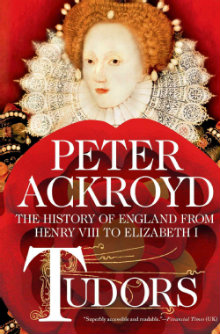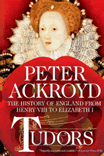Top Ten Books of 2013 - #9
December 20, 2013Tudors: The History of England from Henry VIII to Elizabeth I, by Peter Ackroyd
I confess to having a love affair with 16th century English history. The story of Henry VIII, Katherine of Aragon, Anne Boleyn, Jane Seymour, Anne of Cleves, Katherine Howard, Katherine Parr (my goodness, who can possibly keep up with his multitude of wives?), the boy-king Edward VI, “Bloody” Mary, her half-sister Elizabeth, and countless others has always captivated my attention. Keep reading...

Tudors: The History of England from Henry VIII to Elizabeth I, by Peter Ackroyd (New York: St. Martin’s Press, 2013), 507 pp.
I confess to having a love affair with 16th century English history. The story of Henry VIII, Katherine of Aragon, Anne Boleyn, Jane Seymour, Anne of Cleves, Katherine Howard, Katherine Parr (my goodness, who can possibly keep up with his multitude of wives?), the boy-king Edward VI, “Bloody” Mary, her half-sister Elizabeth, and countless others has always captivated my attention.
So what makes this volume by Ackroyd deserving of inclusion in my list of best books of 2013? After all, there have been countless others devoted to this period in history. In fact, while browsing at Barnes & Noble the other day I came across yet another volume published this year that covers the same period and people. Written by Leanda de Lisle, its title is Tudor: Passion. Manipulation. Murder. The Story of England’s Most Notorious Royal Family (New York: Public Affairs, 2013), 539 pp. Perhaps if I’d read hers first it would be on my list instead of Ackroyd. In any case, her subtitle alone tells you why this royal family has captured the interests of so many: Passion! Manipulation! Murder! And that’s no exaggeration.
Ackroyd’s volume is not only informative, it is flat out fun to read. It is not your typical history, dry and burdened by excessive attention to meaningless detail. He writes with energy and ease and it is a sheer blessing to read. Ackroyd is not free from error, especially when it comes to his obvious prejudice against John Calvin. But his portrayal of the intrigue in Henry’s court (and bedroom) that opened the door to the Reformation making its way into England is fascinating.
Be forewarned: Ackroyd pulls no punches and softens no blows in describing the atrocities that were a commonplace in the 16th century. The simple and disturbing fact is that virtually every problem had a swift and decisive remedy: decapitation. If that didn’t suit the party in power, burning at the stake was also an option. The ease with which rulers sent their enemies (as well as those only suspected of being an enemy) to a gruesome death is nothing short of shocking.
Whereas the whole book is a blast to read, Ackroyd does a much better job in the first half where his focus is Henry than he does in the concluding chapters where Elizabeth is his subject. But it’s all worth the reading.

Write a Comment
Comments for this post have been disabled.